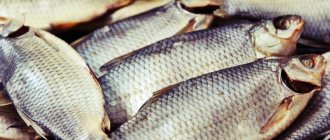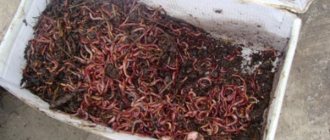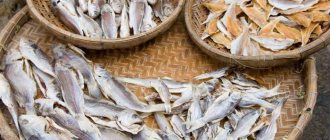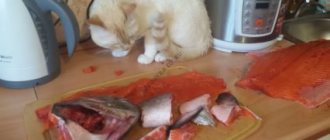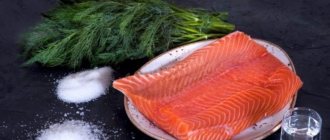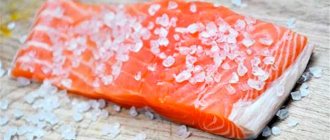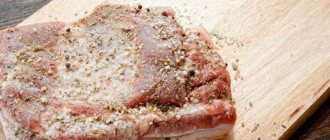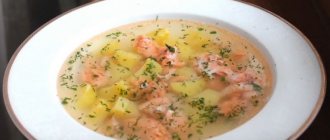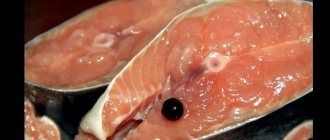General characteristics of paddlefish
Paddlefish is a fish belonging to the paddlefish family and the ray-finned species. They are part of the sturgeon order. Under natural conditions, the paddlefish lives in the fresh waters of Asia and America.
There are two main species of this fish known: the American paddlefish and the psefur (Chinese paddlefish). American paddlefish live in the Mississippi basin, as well as in other rivers that flow into the Gulf of Mexico. Chinese paddlefish live in the Yangtze basin.
These giant fish have been around for over 100 million years. Previously, there were much more of them, and their habitats were more diverse. The paddlefish population has decreased significantly due to pollution of water bodies, active fishing, and a large number of constructed hydroelectric power stations.
The fish stays far from the shore, at a depth of about 2 m. Its body is elongated. The eyes are small, vision is poorly developed. The mouth is motionless.
These fish are quite large: the average size of an adult reaches two meters in length, and the weight is between 70-80 kg. They have a very long nose, which takes up up to a third of the total body length. It is designed for successful hunting: it is the nose-oar that allows you to find food.
Paddlefish have practically no scales on the surface of their bodies. On the back there is one fin slightly offset back.
Paddlefish feed on phytoplankton and zooplankton.
Under natural conditions, they are endangered by birds that feed on fish, lampreys, and some parasitic microorganisms.
Fish pulp not only has high taste: it contains many useful substances and microelements, as well as Omega-3 fatty acids. Paddlefish is good for the thyroid gland, controls the functions of the cardiovascular system, and improves the functioning of the gastrointestinal tract.
Description
The first thing that is hard not to notice when looking at a photo of this fish is its long nose, which plays an important role. It is the nose that performs the function of a kind of locator, with increased sensitivity to surrounding objects. But, besides this feature, the paddlefish has another important difference from other fish representatives - this is the complete absence of scales and small bones. The location and shape of the fins is no different from other types of sturgeon. The head occupies a third of the entire body. The mouth is quite large.
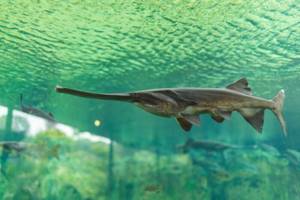
Breeding Features
This fish can be grown for commercial purposes: this species is rare and highly valued. In Russia, paddlefish are bred exclusively artificially. In such conditions, it successfully matures and reproduces.
Growing this fish does not require much labor: the paddlefish does not need any special conditions. When breeding this type of fish on an industrial scale, you can get up to 100 kg of paddlefish from 1 hectare of pond. Its cultivation is most effective in the conditions of specialized farms in the presence of reservoir reserves.
The advantage of this type of business is that paddlefish can be raised together with other fish that feed on plant foods. In addition, this fish safely survives the winter in carp wintering ponds.
Another important advantage of breeding such fish is their rapid growth. Paddlefish are classified as fast-growing organisms. The rapid growth of fish of this species is due to the fact that paddlefish have a high ability to filter plankton using a wide filtration plate. The fish actively captures food items, so its food spectrum expands significantly. The paddlefish's mouth is constantly open, so when swimming, they always grab suitable food.
Fish are oxygen demanding, so it is necessary to regularly monitor the oxygen content in the water.

What is the name of a fish with a long nose?
Istiophoridae (marlin) is a fish with an interesting snout structure that can reach speeds under water of up to 110 km/h. The nose is spear-shaped, long, thin. The two dorsal fins are located close to each other. The back of the fish is dark blue, and the sides have a silver tint. The body is powerful, somewhat flattened at the sides. Marlin feeds on tuna, crabs, shrimp, and bottom organisms.
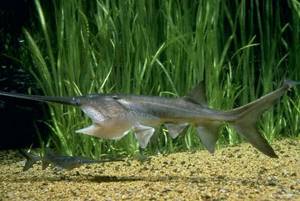
And the rapid development of digital technology has made it possible to create ultra-durable cameras that can shoot underwater. Thanks to this, the world saw photographs depicting animals living at the bottom of the ocean.
The longnose chimera is caught as bycatch during deep-sea bottom trawling.
This is a small marine bony fish of the pipefish family of the order Pipefish. Seahorses lead a sedentary lifestyle; they attach their flexible tails to plant stems, and thanks to numerous spines, outgrowths on the body and iridescent colors, they completely blend into the background. This is how they protect themselves from predators and camouflage themselves while hunting for food. Skates feed on small crustaceans and shrimp. The tubular stigma acts like a pipette - the prey is drawn into the mouth along with water.
Construction of a reservoir for breeding paddlefish
Paddlefish are a valuable object for reservoirs, cooling ponds, and lakes in the central and southern zones of Russia. Most of these reservoirs do not have conditions for fish reproduction, so they require periodic stocking and installation of the necessary equipment.
To start a business in breeding and raising paddlefish, you need to prepare a reservoir for this. The best climatic zones for paddlefish breeding in the territories of the countries of the former Soviet Union are the forest-steppe and steppe physiographic zones.
It is permissible to grow paddlefish breeding material in ordinary carp ponds. The reservoir must have a well-planned bed.
Fish tanks in which paddlefish are grown must be equipped with a direct-flow water use system. This means that water enters reservoirs from a water source and is then discharged into a receiving water reservoir.
It is recommended to grow fish of the same age group in one pond, since otherwise the growth and development of older fish, which are much more demanding of living conditions, will slow down.
When arranging a pond, the following characteristics must be taken into account:
- the temperature should be between 22-26 degrees;
- the optimal level of oxygen dissolved in water is at least 5 mg/l;
- optimal salinity level – up to 4%;
- biomass of zooplankton, which is the natural food for paddlefish, is 5 g/cu. m.
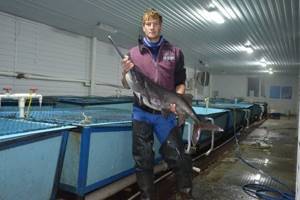
Before releasing the fry, organic fertilizers are applied to the pond bed. In this case, the soil needs to be harrowed to a depth of 5-7 cm.
Mineral fertilizers are applied only in well-dissolved form. Rotted manure, lime, superphosphate, and potassium permanganate are usually used as fertilizers.
If fish is grown in complex reservoirs, then their area should be no more than 2000 hectares. The depth of the non-freezing water layer must be at least 1.5 m.
Habitats in Russia
North America can rightfully be considered the homeland of the paddlefish. It is here in the Mississippi River that the main habitat of this marine species is located. During flood periods, fish tend to swim to nearby lakes. But, after a short period of time, he returns to his native place again. Since the fish is unpretentious to its living conditions, it feels quite comfortable in different climatic conditions.
In the depths of water, the water carrier prefers to be in the middle water columns. Selects exclusively fresh waters; this individual sometimes jumps out of the water, striking the water surface with its “oar.”
Today paddlefish can also be found in Russian waters. Fish were brought here in the middle of the last century. He managed to acclimatize only in a few places. These include:
- Kostroma region.
- Oktyabrsky district of Primorye.
- Krasnodar reservoir.
Based on the small list of paddlefish habitats in Russia, we can talk about maladaptation of this fish species in this area. Paddlefish are grown artificially for commercial purposes at several fisheries.
Necessary equipment, material
First you need to purchase breeding material. Each fry weighs about 25 mg. The recommended planting density is 2000-3000 specimens per 1 hectare.
Regular carp ponds do not require special equipment. The main thing is to ensure complete drainage and a system of independent water supply and collection. It is also necessary to ensure constant growth of phyto- and zooplankton.
You will need net tools for catching fish and containers for transporting paddlefish, equipped with devices for water aeration.
Captured paddlefish are examined, weight assessed and measured. Catching this fish is not difficult.
Paddlefish fishing
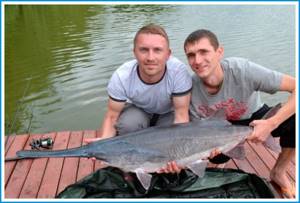
According to fishermen, paddlefish were caught in Lake Velikoye (Kostroma Region), as well as in Primorye, in the Strugov Reservoir.
You can also fish for paddlefish in private ponds where this fish is bred.
It is usually caught using bottom tackle, on a feeder. According to fishermen, an ordinary worm is used as bait. In the reservoirs of Ukraine and Russia, mainly small individuals are found.
Paddlefish fishing is active in America, where fishermen come across fairly large specimens.
Features of breeding paddlefish on a home farm
Paddlefish reach sexual maturity at 5-10 years of age, the total life cycle is up to 55 years. The onset of puberty largely depends on climatic conditions.
To stimulate the maturation of producers, the pituitary glands of representatives of sturgeon fish are used.
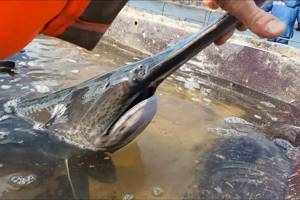
Reproduction
Work on artificial breeding should begin when the water temperature becomes stable and is within 13-15 degrees above zero.
The complete development cycle of the paddlefish includes 5 successive stages:
- Obtaining fertilized eggs and embryos.
- Raising larvae.
- Rearing juveniles.
- Obtaining marketable fish.
- Growing producers.
Spawning for these sturgeon representatives begins in late April - early May. Paddlefish spawn in schools. Females spawn at depths from 2 to 12 m.
One female paddlefish lays up to 250,000 eggs. The diameter of each of them is about 2.5 mm. Paddlefish caviar has a sticky consistency and is dark in color.
Females do not spawn annually.
Features of cultivation
The fry appear after 9 days. They grow quickly and gain weight: by the age of one year their length reaches 70 cm.
It should be borne in mind that it is not recommended to plant fry of this fish in ponds due to low survival rate. It is best to pre-grow them in trays, bathtubs or pools with running water.
Dead larvae must be collected regularly. Young animals need to be sorted by size.
Juveniles that have grown in pools and reached 5 g can be released into ponds. By autumn, the specimens will gain the required weight.

In the presence of favorable conditions, the weight gain of juvenile paddlefish will be about 6 kg in one summer, in less favorable conditions – up to 3 kg.
Dangers
A danger to fish and fry is the strong bloom of water and the abundance of filament, in which younger representatives of sturgeon can become entangled. To suppress excess vegetation in the pond, grass carp are planted in the pond.
Also, the development and vital activity of these fish is negatively affected by the insufficient technical equipment of fish breeding facilities and inadequate nutrition of paddlefish during the growing period, until they reach viable stages.
Nutrition
In order for the fish to actively develop and gain weight, the average mass of zooplankton should be in the range of 3-5 g/cu. m.
The paddlefish is the only species of sturgeon that feeds exclusively on natural vegetation found in the reservoir. A special feature of the diet of these fish is that at the moment of hunting they begin to violently twirl their tails so that more microorganisms rise up from the bottom of the reservoir, which the paddlefish eat.
Both adults and young animals feed on plankton. In particular, this fish prefers detritus, phytoplankton and lower crustaceans. Much less commonly, paddlefish consume insect larvae. When they feel the need for food, they rise closer to the surface of the water with their mouths open. Fish pass streams of water through their gills. This kind of filtration ensures that all plankton is retained in the mouth and then sent to the stomach.
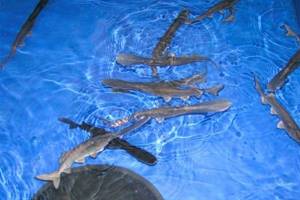
Reproduction and nutrition
Before the breeding season, paddlefish gather in huge flocks, sometimes numbering several thousand individuals. All schools are distributed according to the age characteristics of the fish. In the Mississippi River, the paddlefish spawning season begins in early spring. For spawning, the fish looks for a place with a gravel substrate and a water temperature of 15-17 degrees. It is important that the depth of the selected location is more than 4 meters.
The paddlefish is a species of fish that reaches sexual maturity at 13 years of age. By this age, the body length of the fish reaches 1.5 meters. Individuals spawn once every 5-7 years. The female is capable of laying several thousand eggs. However, most of them die.
The average lifespan of a paddlefish is 60 years.
As food, the paddlefish consumes exclusively the following products:
- Daphnia.
- Seaweed.
- Rotifers.
- Aquatic or aerial insects.
When you see this individual, you can notice that it always swims with its mouth wide open. Why? During the life of a paddlefish, there is a constant process of filtering out plankton, which is retained for some time on the gill hairs. If this did not happen, the paddlefish would hardly be able to live for a long time. He needs a lot of strength to live.
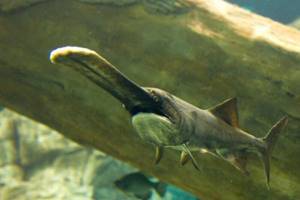
Application in the food industry
Paddlefish fish is actively used in the food industry for subsequent processing. It has high nutritional value.
These sturgeon representatives are especially fatty. Their caviar is considered a delicacy.
Since the muscle tissue of this type of fish contains a lot of fat, they can be used to prepare smoked meats of excellent quality. In particular, hot smoked products with a unique taste are prepared from paddlefish.
The percentage of meat yield of paddlefish is higher than that of sturgeon representatives such as stellate sturgeon and sturgeon - up to 61%.
Heat treatment of fish helps eliminate the specific smell and peculiar taste of dampness that are characteristic of the muscle tissue of these sturgeon representatives.
Paddlefish liver is also valuable for the food industry. It has a delicate and light consistency and is easily absorbed. The liver is used to make canned products.
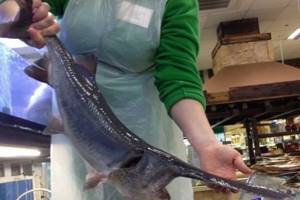
Paddlefish Recipes
Paddlefish soup
Ingredients:
- large fish – 5-7 kilograms,
- onions – 2 pieces,
- carrots – 3 pieces,
- salt - to taste.
Cooking steps:
- We clean, gut the fish, cut off the head.
- Boil water and add salt to it.
- throw chopped onions and carrots into boiling water,
- After 15 minutes, add pieces of fish, including the head and tail.
- add spices and bay leaf if desired.
- cook for 20 minutes, skimming foam regularly.
- after the soup is cooked, add the herbs and let it brew for 5-10 minutes,
- We take out the pieces of fish and onions from the fish soup, put them on a separate dish, and pour the fish soup into plates.
Bon appetit!
Paddlefish shish kebab
Ingredients:
- large paddlefish meat,
- milk – 1 liter,
- salt,
- lemon,
- greenery.
Cooking steps:
- cut the fish into large pieces and sprinkle with lemon juice,
- salt, pour milk over the fish and leave for a while,
- prepare coals for cooking, oak is best,
- cook the kebab for 15 minutes until golden brown
- Serve with herbs and white wine.
Bon appetit!
Unfortunately, the paddlefish, an interesting-looking fish, can rarely be found here. It is mainly bred artificially, and the meat and caviar of this fish are not cheap. However, paddlefish make amazing fish soup and shish kebab.
Business plan for growing and breeding paddlefish
Since paddlefish are not too picky about their living conditions, with the right approach and organization of the process of raising them, the business of breeding fish of this species will become promising and profitable.
The total costs of organizing a business, including the stage of preparing a reservoir, purchasing fry and other necessary investments, will amount to about 1,000,000 rubles. Paddlefish meat and caviar are expensive, so the payback period will be about 1-1.5 years.
The profitability of paddlefish breeding, provided the fish reaches marketable weight (1.6-3 kg), will be about 90%. If an entrepreneur simultaneously collects caviar, then this figure increases several times and varies between 900-1800%.
Paddlefish are representatives of the sturgeon family that feed on zooplankton and phytoplankton and are not too demanding on their living conditions. When breeding this fish, you can make a good profit, especially if the caviar is collected. Various canned foods and hot and cold smoked products are prepared using paddlefish meat.
0
0
Copy link
How to usually prepare paddlefish meat
This fish can be prepared in various ways. Fish is fried, boiled, smoked, steamed, baked, and eaten raw. Before starting cooking, it is important to ensure the freshness of the fish. Carefully examine the wrapper and the name of the manufacturer. Proceed with the inspection: the carcass and gills should be pink, the eyes should be transparent.
Regardless of the chosen cooking option, the fish must be properly prepared. To do this, you need to cut off the fins and remove the insides, then rinse under running water.
